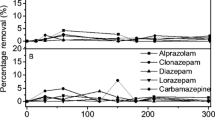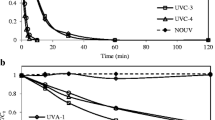Abstract
Methamphetamine, ketamine, and morphine, found in the influent and effluent of domestic treatment plants as well as in rivers, were selected as parent compounds in this study. This investigation examined the photocatalytic removal of methamphetamine, ketamine, and morphine, from municipal wastewater effluents using illuminated TiO2 and ZnO. HPLC–MS/MS was used to measure the concentration of these drugs during reactions. UV light of 254 nm alone is capable of destroying the drugs to some extent without the TiO2 or ZnO photocatalyst, while UV light of 365 nm must be coupled with the photocatalysts to be effective. UV light of 254 nm in the presence of 0.04 g/L of TiO2 was most effective, eliminating all three drugs within 5 min; ten times as much of ZnO were required to demonstrate comparable removal. Among the three tested drugs, morphine is most readily removed by the photocatalytic treatment.





Similar content being viewed by others
References
Chong MY, Chan KW, Cheng ATA (1999) Substance use disorders among adolescents in Taiwan: prevalence, sociodemographic correlates and psychiatric co-morbidity. Psychol Med 29:1387–1396
Kuo PH, Yang HJ, Soong WT, Chen WJ (2002) Substance use among adolescents in Taiwan: associated personality traits, incompetence, and behavioral/emotional problems. Drug Alcohol Depend 67:27–39
Metcalfe C, Tindale K, Li H, Rodayan A, Yargeau V (2010) Illicit drugs in Canadian municipal wastewater and estimates of community drug use. Environ Pollut 158:3179–3185
Daughton CG, Ternes TA (1999) Pharmaceuticals and personal care products in the environment: agents of subtle change? Environ Health Perspect 107:907–938
Loganathan B, Phillips M, Mowery H, Jones-Lepp TL (2009) Contamination profiles and mass loadings of macrolide antibiotics and illicit drugs from a small urban wastewater treatment plant. Chemosphere 75:70–77
Van-Nuijs ALN, Pecceu B, Theunis L, Dubois N, Charlier C, Jorens PG, Bervoets L, Blust R, Neels H, Covaci A (2009) Spatial and temporal variations in the occurrence of cocaine and benzoylecgonine in waste and surface water from Belgium and removal during wastewater treatment. Water Res 43:1341–1349
Van-Nuijs ALN, Pecceu B, Theunis L, Dubois N, Charlier C, Jorens PG, Bervoets L, Blust R, Neels H, Covaci A (2009) Cocaine and metabolites in waste and surface water across Belgium. Environ Pollut 157:123–129
Kasprzyk-Hordern B, Dinsdale RM, Guwy AJ (2009) The removal pharmaceuticals, personal care products, endocrine disruptors and illicit drugs during wastewater treatment and its impact on the quality of receiving waters. Water Res 43:363–380
Lin AYC, Wang XH, Lin CF (2010) Impact of wastewaters and hospital effluents on the occurrence of controlled substances in surface waters. Chemosphere 81:562–570
Boleda MR, Galceran MT, Ventura F (2009) Monitoring of opiates, cannabinoids and their metabolites in wastewater, surface water and finished water in Catalonia, Spain. Water Res 43:1126–1136
Castiglioni S, Zuccato E, Crisci E, Chiabrando C, Fanelli R, Bagnati R (2006) Identification and measurement of illicit drugs and their metabolites in urban wastewater by liquid chromatography-tandem mass spectrometry. Anal Chem 78:8421–8429
Kasprzyk-Hordern B, Dinsdale RM, Guwy AJ (2009) Illicit drugs and pharmaceuticals in the environment—forensic applications of environmental data. Part 1: estimation of the usage of drugs in local communities. Environ Pollut 157:1773–1777
Posttigo C, de Alda MJL, Barcelo D (2010) Drugs of abuse and their metabolites in the Ebro river basin: occurrence in sewage and surface water, sewage treatment plants removal efficiency, and collective drug usage estimation. Environ Internal 36:75–84
Kasprzyk-Hordern B, Dinsdale RM, Guwy AJ (2009) Illicit drugs and pharmaceuticals in the environment—forensic applications of environmental data. Part 2: pharmaceuticals as chemical markers of faecal water contamination. Environ Pollut 157:1778–1786
Linsebigler A, Lu G Jr, Yates JT (1995) Photocatalysis on TiO2 surfaces: principles, mechanisms, and selected results. Chem Rev 95:735–758
Hadjiivanov KI, Klissurski DG (1996) Surface chemistry of titania (anatase) and titania-supported catalysts. Chem Soc Rev 25:61–69
Konstantinou IK, Albanis TA (2004) TiO2-assisted photocatalytic degradation of azo dyes in aqueous solution: kinetic and mechanistic investigations: a review. Appl Catal B: Environ 49:1–14
Lo SC, Lin CF, Wu CH, Hsieh PH (2004) Capability of coupled CdSe/TiO2 for photocatalytic degradation of 4-chlorophenol. J Hazard Mater 114:183–190
Lin CF, Wu CH, Onn SN (2008) Degradation of 4-chlorophenol in TiO2, WO3, SnO2, TiO2/WO3 and TiO2/SnO2 systems. J Hazard Mater 154:1033–1039
Wu CH (2008) Effects of sonication on decolorization of C.I. Reactive Red 198 in UV/ZnO system. J Hazard Mater 153:1254–1261
Wu CH (2008) Effects of operational parameters on the decolorization of C.I. Reactive Red 198 in UV/TiO2-based systems. Dyes Pigm 77:31–38
Yu CH, Wu CH, Ho TH, Hong PKA (2010) Decolorization of C.I. Reactive Black 5 in UV/TiO2, UV/oxidant and UV/TiO2/oxidant systems: a comparative study. Chem Eng J 158:578–583
Gouvea CAK, Wypych F, Moraes SG, Duran N, Nagata N, Peralta-Zamora P (2000) Semiconductor-assisted photocatalytic degradation of reactive dyes in aqueous solution. Chemosphere 40:433–440
Sakthivel S, Neppolian B, Shankar MV, Arabindoo B, Palanichamy M, Murugesan V (2003) Solar photocatalytic degradation of azo dye: comparison of photocatalytic efficiency of ZnO and TiO2. Solar Energy Mater Solar Cells 77:65–82
Kanmoni VGG, Daniel S, Raj GAG (2012) Photocatalytic degradation of chlorpyrifos in aqueous suspensions using nanocrystals of ZnO and TiO2. Reac Kinet Mech Cat 106:325–339
Khodja AA, Sehili T, Pilichowski JF, Boule P (2001) Photocatalytic degradation of 2-phenyphenol on TiO2 and ZnO in aqueous suspensions. J Photochem Photobiol A 141:231–239
Wang J, Pan Z, Zhang Z, Zhang X, Wen F, Ma T, Jiang Y, Wang L, Xu L, Kang P (2006) Sonocatalytic degradation of methyl parathion in the presence of nanometer and ordinary anatase titanium dioxide catalysts and comparison of their sonocatalytic abilities. Ultrason Sonochem 13:493–500
Ince NH, Tezcanli G (2001) Reactive dyestuff degradation by combined sonolysis and ozonation. Dyes Pigm 49:145–153
So CM, Cheng MY, Yu JC, Wong PK (2002) Degradation of azo dye Procion Red MX-5B by photocatalytic oxidation. Chemosphere 46:905–912
Wu CH, Kuo CY, Hong PKA (2011) Effects of operational parameters on decolorization of C.I. Reactive Black 5 in UV/TiO2 system. Water Sci Technol 63:1032–1036
Wu MC, Wu CH (2011) Decolorization of C.I. Reactive Red 198 in UV/oxidant and UV/TiO2/oxidant systems. React Kinet Mech Catal 104:281–290
Wu CH, Hong PKA, Jian MY (2012) Decolorization of Reactive Red 2 in Fenton and Fenton-like systems: effects of ultrasound and ultraviolet irradiation. React Kinet Mech Catal 106:11–24
Author information
Authors and Affiliations
Corresponding author
Rights and permissions
About this article
Cite this article
Lin, CF., Shiu, YJ., Kuo, CS. et al. Photocatalytic degradation of morphine, methamphetamine, and ketamine by illuminated TiO2 and ZnO. Reac Kinet Mech Cat 110, 559–574 (2013). https://doi.org/10.1007/s11144-013-0621-y
Received:
Accepted:
Published:
Issue Date:
DOI: https://doi.org/10.1007/s11144-013-0621-y




